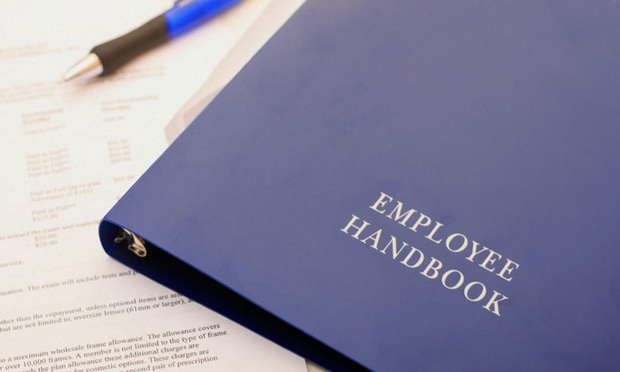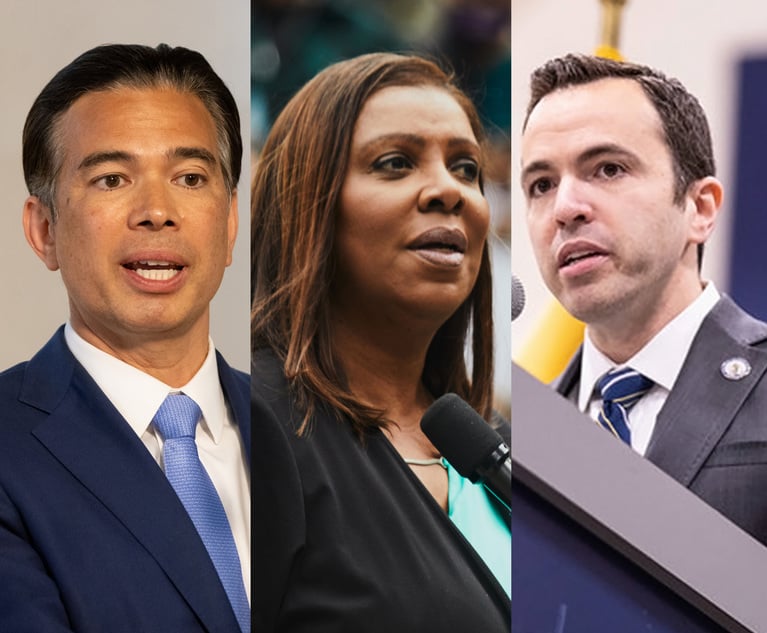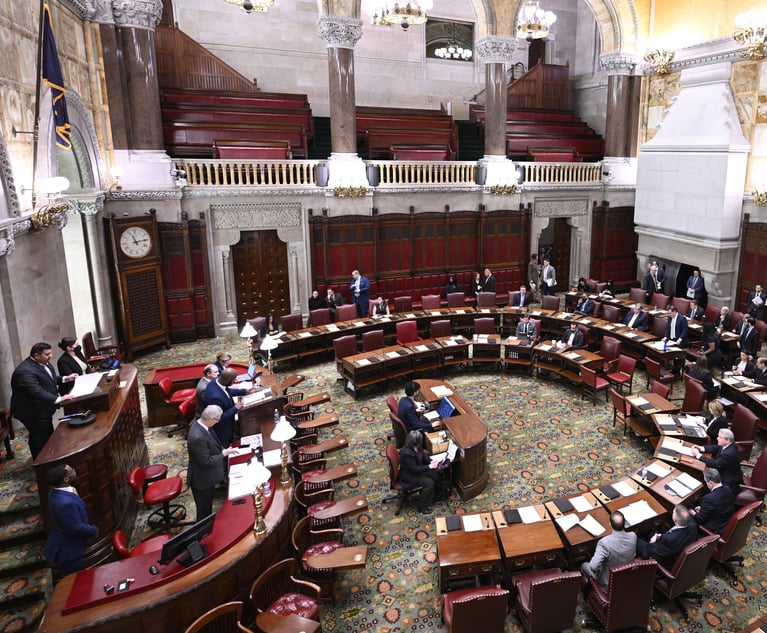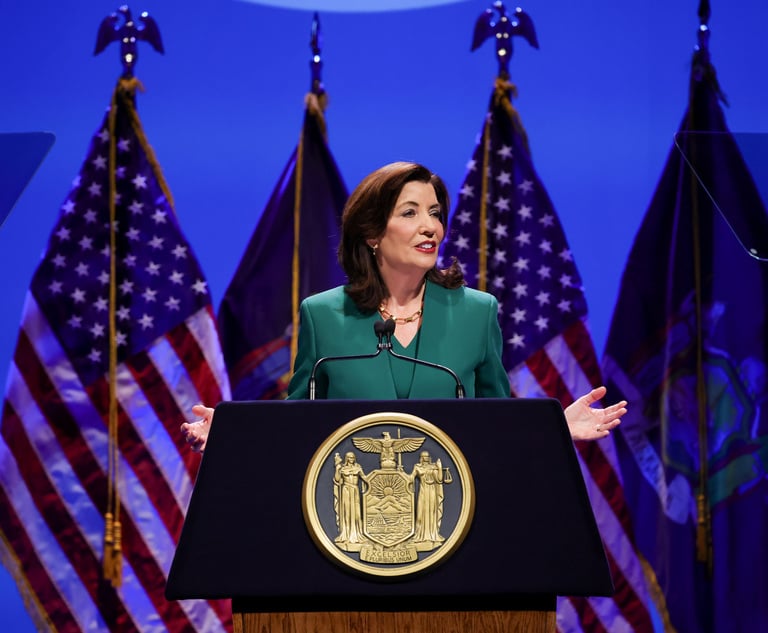Hairdon'ts in NYC: Race Discrimination Based on Hairstyle Is Illegal
On Feb. 18, 2019, the New York City Commission on Human Rights released new legal enforcement guidance clarifying that “grooming or appearance policies that ban, limit, or otherwise restrict natural hairstyles or hairstyles associated with Black people generally violate the NYCHRL's [New York City Human Rights Law] anti-discrimination policies.”
April 25, 2019 at 12:30 PM
8 minute read
 On Feb. 18, 2019, the New York City Commission on Human Rights (the Commission) released new legal enforcement guidance clarifying that “grooming or appearance policies that ban, limit, or otherwise restrict natural hairstyles or hairstyles associated with Black people generally violate the NYCHRL's [New York City Human Rights Law] anti-discrimination policies.” The Commission recognizes that grooming and appearance policies affect many communities, but focuses its legal guidance on policies addressing hair or hairstyles most commonly associated with Black people, as they are “frequent targets of race discrimination based on hair.”
On Feb. 18, 2019, the New York City Commission on Human Rights (the Commission) released new legal enforcement guidance clarifying that “grooming or appearance policies that ban, limit, or otherwise restrict natural hairstyles or hairstyles associated with Black people generally violate the NYCHRL's [New York City Human Rights Law] anti-discrimination policies.” The Commission recognizes that grooming and appearance policies affect many communities, but focuses its legal guidance on policies addressing hair or hairstyles most commonly associated with Black people, as they are “frequent targets of race discrimination based on hair.”
The NYCHRL prohibits race discrimination by employers and providers of housing or public accommodations. According to the Commission, anti-Black discrimination is often based on characteristics and cultural practices associated with being Black. The Commission defines “Black people” as “those who identify as African, African American, Afro-Caribbean, Afro-Latin-x/a/o or otherwise having African or Black ancestry.” Hair in an uncut or untrimmed state and hairstyles such as locs, cornrows, twists, braids, Bantu knots, fades and Afros are protected racial characteristics as “they are an inherent part of Black identity.” Prohibitions on these hairstyles or natural hair are typically “rooted in white standards of appearance and perpetuate racist stereotypes that Black hairstyles are unprofessional.” The Commission notes that these prohibitions may also cause serious medical harm and/or emotional distress. The Commission explained Black hair that is repeatedly manipulated by tools, like straighteners, or styled using chemicals, like products to relax hair from its natural state, is particularly susceptible to conditions causing serious hair breakage or hair loss, severe skin and scalp damage, and even seemingly unrelated conditions, like uterine fibroids in women.
The Commission is the first agency in the country to announce protections and enforcement actions against this type of discrimination. The Equal Employment Opportunity Commission previously released a compliance manual that touched on the subject of race discrimination based on natural hair, prohibiting bans on natural hairstyles such as Afros. The manual is not binding on courts though, similar to the Commission's new guidance. No federal case law protecting hairstyles exists, and some courts have even interpreted federal law to permit such bans. California is looking to make a statutory amendment—legislation proposed in January would amend the California Fair Employment and Housing Act definition of “race” to also explicitly include traits historically associated with race, including hair texture and certain hairstyles.
HairDON'Ts in the Workplace
The Commission's guidance notably affects policies in the workplace. While employers may impose certain grooming and appearance standards, they may not enact policies that require alteration of natural hair, ban Black hairstyles or target Black hairstyles. Policies that appear facially neutral but are discriminatorily applied are also impermissible under the NYCHRL. Moreover, employers may not harass or impose unfair conditions against employees based on aspects of their appearance associated with their race. For example, the following policies or situations would be considered discrimination in violation of the NYCHRL:
• A grooming policy to maintain a “neat and orderly” appearance that prohibits cornrows or locs;
• A grooming policy requiring employees to straighten or relax their hair to conform to the company's appearance standards;
• A grooming policy limiting hair length, which would consequently limit Afros;
• Requiring Black people to obtain approval to change hairstyles but not requiring other people to do the same;
• Informing Black employees with cornrows that they must change hairstyles to work in customer-facing roles;
• Refusing to hire Black applicants with locs because their hairstyle does not fit the “company image”; and
• Requiring Black employees to hide their hair with an accessory, such as a hat or visor.
HairDON'Ts in Places of Public Accommodation
Under the NYCHRL, discrimination in areas of public accommodation by anyone who provides goods and services to the general public is prohibited. Public accommodations may include schools, fitness clubs, nightclubs, cultural institutions, stores, banks, hotels, restaurants, medical offices, theaters, hospitals and more. While the guidance focuses on discrimination in schools, it explicitly acknowledges that protections against hair discrimination in places of public accommodation extend to all public accommodations, not just schools. The Commission further explains that “it is no justification to prohibit natural hair or hairstyles because they are perceived to be a distraction or because of speculative health or safety concerns.” Examples of violations include:
• A private school informing a Black student she must change her Afro because it is a distraction in the classroom;
• A dance company requiring girls and women to remove their braids or alter their Afro and only wear a “smooth bun” to participate in classes;
• A nightclub turning away a patron because her natural hairstyle does not meet their dress code; and
• A fitness club prohibiting a Black athlete with locs from participating in an athletic competition because his hair is below his shoulders but allowing white athletes with long hair to tie their hair up.
HairDOs in the Workplace and Places of Public Accommodation
Though employers and places of public accommodation must be prudent when addressing grooming and appearance policies, the NYCHRL does not completely ban any and all policies related to hair and appearances. Hair not associated with a racial or religious culture—such as hair dyed fuchsia or neon green—is not protected expression under the law.
If employers have legitimate health or safety concerns with respect to grooming standards, the Commission encourages employers to consider alternative ways to manage those concerns prior to banning or restricting employee hairstyles. This may include using hair ties, hairnets, head coverings or alternative safety equipment that accommodates various hair textures and hairstyles. If employers move forward with a ban or restriction on hairstyles due to health and safety, they should ensure their policies are implemented and enforced equally among all protected classes of employees. A restaurant, for example, generally has legitimate concerns about food contamination from hair. If the restaurant requires that kitchen employees with shoulder-length hair or longer secure their hair using a hair tie, the restaurant should apply and enforce the requirement equally, notwithstanding style of hair, race, gender, gender identity or any other protected class.
What This Means for Employers and Other Covered Entities
Employers and places of public accommodation should evaluate their existing grooming and appearance standards, policies and procedures “to ensure they are inclusive of the racial, ethnic, and cultural identities and practices” associated with not just Black communities, but all other historically marginalized communities as well. Native Americans, for example, often wear braids or Mohawks. It would be discriminatory for employers to prohibit extreme or fad hairstyles including Mohawks.
Employers must be mindful of other kinds of discrimination as well. Hair and clothing related to religion have long been protected characteristics under §8-107 of the NYCHRL, and employers are likely already familiar with the process to reasonably accommodate these characteristics. However, there are nuanced differences between religious discrimination and race discrimination. For example, a policy prohibiting locs may not constitute religious discrimination if a Rastafarian or Hindu employee is reasonably accommodated, whereas that same policy would constitute race discrimination simply by targeting a Black hairstyle.
The NYCHRL (joined earlier this year by the New York State Human Rights Law) prohibits discrimination based on gender identity and expression. The Commission's guidance likewise provides that grooming policies, including rules on hairstyles and hair lengths, that are differentiated based on gender violate the NYCHRL. Requiring employees to conform to a standard traditionally associated with their assigned gender is impermissible. For example, a grooming policy prohibiting men from wearing hair past their shoulders would constitute discrimination based on gender identity or expression. The same policy could now also constitute discrimination based on race, as Native Americans may maintain long hair as part of their cultural identity.
Existing policies and procedures that are facially neutral may still run afoul of the NYCHRL. In particular, employee handbooks with grooming policies designed to promote a certain corporate image or to cater to certain customer preferences should proceed with caution, as “employees' hair texture or hairstyle generally has no bearing on their ability to perform the essential functions of a job.” Policies should be carefully worded.
Even if employee grooming policies are in full compliance with the NYCHRL, employers can still be liable for discrimination if policies are enforced unequally. Managers, supervisors and other relevant personnel should be trained regarding appropriate standards and procedures. This includes spotting and differentiating between situations where limitations on hairstyles are appropriate and situations where they constitute discrimination.
New York City's guidance on hair discrimination, requiring acceptance of cultural appearances, is one more step in the expansion of laws and attitudes embracing a more diverse society. Employers and other covered entities would be prudent to consult counsel with discrimination law experience for review of policies and procedures and training on “hairdos and hairdon'ts,” as the NYCHRL presents intricate and complex issues that may not always be obvious.
Eve I. Klein is chair of Duane Morris' employment, labor, benefits and immigration practice group and serves as the firm's employment counsel. Law clerk Rebecca Ruffer assisted with the preparation of this article.
This content has been archived. It is available through our partners, LexisNexis® and Bloomberg Law.
To view this content, please continue to their sites.
Not a Lexis Subscriber?
Subscribe Now
Not a Bloomberg Law Subscriber?
Subscribe Now
NOT FOR REPRINT
© 2025 ALM Global, LLC, All Rights Reserved. Request academic re-use from www.copyright.com. All other uses, submit a request to [email protected]. For more information visit Asset & Logo Licensing.
You Might Like
View All

Federal Judge Pauses Trump Funding Freeze as Democratic AGs Plan Suit
4 minute read
Relaxing Penalties on Discovery Noncompliance Allows Criminal Cases to Get Decided on Merit
5 minute read
Bipartisan Lawmakers to Hochul Urge Greater Student Loan Forgiveness for Public-Interest Lawyers
Trending Stories
- 1Understanding the HEMS Standard in Trusts
- 2Mergers Are About People, Not Paperwork: Here’s Why
- 3Wachtell Partner Leaves to Chair Latham's Liability Management Practice
- 4Morris Nichols Partners to Be Involved With PLI Program
- 5How I Made Practice Group Chair: 'Cultivating a Culture of Mutual Trust Is Essential,' Says Gina Piazza of Tarter Krinsky & Drogin
Who Got The Work
J. Brugh Lower of Gibbons has entered an appearance for industrial equipment supplier Devco Corporation in a pending trademark infringement lawsuit. The suit, accusing the defendant of selling knock-off Graco products, was filed Dec. 18 in New Jersey District Court by Rivkin Radler on behalf of Graco Inc. and Graco Minnesota. The case, assigned to U.S. District Judge Zahid N. Quraishi, is 3:24-cv-11294, Graco Inc. et al v. Devco Corporation.
Who Got The Work
Rebecca Maller-Stein and Kent A. Yalowitz of Arnold & Porter Kaye Scholer have entered their appearances for Hanaco Venture Capital and its executives, Lior Prosor and David Frankel, in a pending securities lawsuit. The action, filed on Dec. 24 in New York Southern District Court by Zell, Aron & Co. on behalf of Goldeneye Advisors, accuses the defendants of negligently and fraudulently managing the plaintiff's $1 million investment. The case, assigned to U.S. District Judge Vernon S. Broderick, is 1:24-cv-09918, Goldeneye Advisors, LLC v. Hanaco Venture Capital, Ltd. et al.
Who Got The Work
Attorneys from A&O Shearman has stepped in as defense counsel for Toronto-Dominion Bank and other defendants in a pending securities class action. The suit, filed Dec. 11 in New York Southern District Court by Bleichmar Fonti & Auld, accuses the defendants of concealing the bank's 'pervasive' deficiencies in regards to its compliance with the Bank Secrecy Act and the quality of its anti-money laundering controls. The case, assigned to U.S. District Judge Arun Subramanian, is 1:24-cv-09445, Gonzalez v. The Toronto-Dominion Bank et al.
Who Got The Work
Crown Castle International, a Pennsylvania company providing shared communications infrastructure, has turned to Luke D. Wolf of Gordon Rees Scully Mansukhani to fend off a pending breach-of-contract lawsuit. The court action, filed Nov. 25 in Michigan Eastern District Court by Hooper Hathaway PC on behalf of The Town Residences LLC, accuses Crown Castle of failing to transfer approximately $30,000 in utility payments from T-Mobile in breach of a roof-top lease and assignment agreement. The case, assigned to U.S. District Judge Susan K. Declercq, is 2:24-cv-13131, The Town Residences LLC v. T-Mobile US, Inc. et al.
Who Got The Work
Wilfred P. Coronato and Daniel M. Schwartz of McCarter & English have stepped in as defense counsel to Electrolux Home Products Inc. in a pending product liability lawsuit. The court action, filed Nov. 26 in New York Eastern District Court by Poulos Lopiccolo PC and Nagel Rice LLP on behalf of David Stern, alleges that the defendant's refrigerators’ drawers and shelving repeatedly break and fall apart within months after purchase. The case, assigned to U.S. District Judge Joan M. Azrack, is 2:24-cv-08204, Stern v. Electrolux Home Products, Inc.
Featured Firms
Law Offices of Gary Martin Hays & Associates, P.C.
(470) 294-1674
Law Offices of Mark E. Salomone
(857) 444-6468
Smith & Hassler
(713) 739-1250






